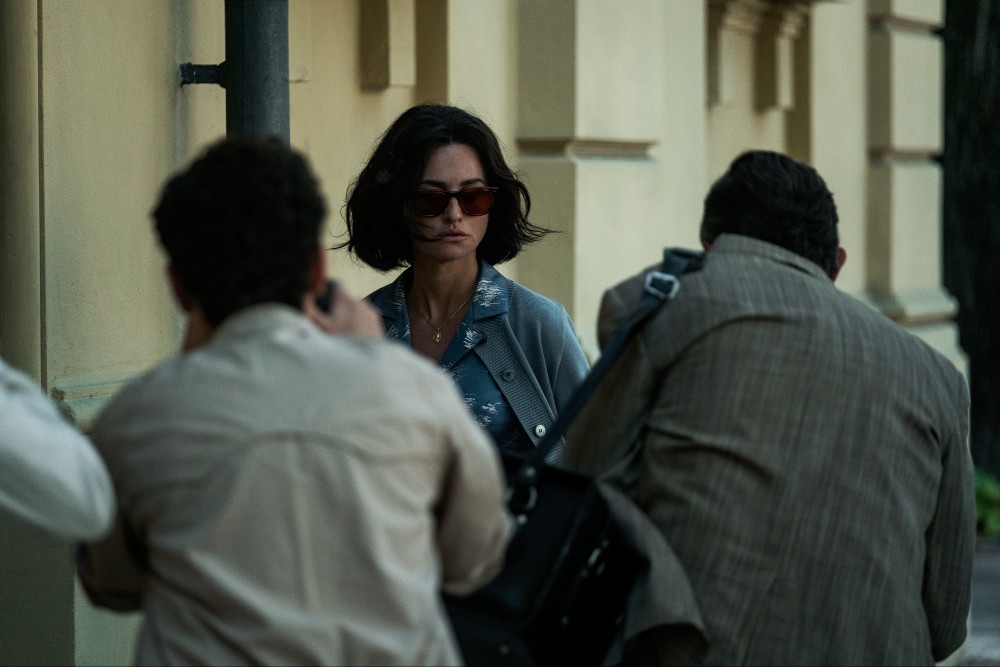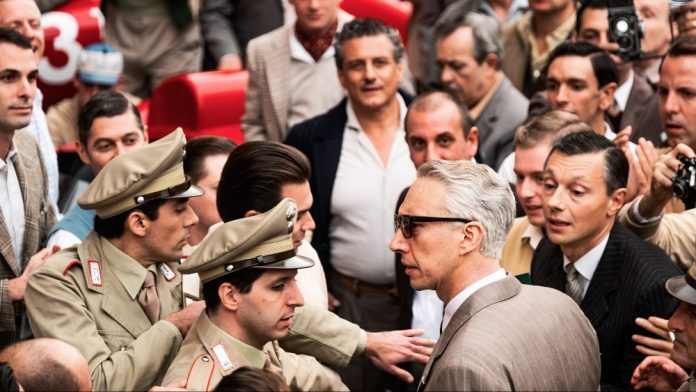It’s always a joy to have a new movie from filmmaker Michael Mann, since his movies have become fewer and further in-between. Even so, it’s a little odd that for his new movie, Ferrari, he has cast Adam Driver as the titular racer-turned-carmaker Enzo Ferrari, coming so soon after he played another Italian icon in Ridley Scott’s House of Gucci.
Adapted from Brock Yates’ book, Enzo Ferrari: The Man, The Cars, The Races, The Machine, by screenwriter Troy Kennedy Martin, it isn’t hard to see why Mann may have wanted to tell this story and make this movie. Set in 1957, ten years after Ferrari began making cars and at a time when his auto empire is in crisis, the film spends much time exploring his dual relationship with wife and business partner Laura (Penélope Cruz) and his mistress Lina Lardi (Shailene Woodley) and mother of his bastard son Pierro. Years earlier, Enzo and Laura lost their own son, something that’s been hanging over them as the Ferrari company is floundering. Enzo realizes that the only way to turn things around is to have his racing team win the grueling 1000-mile Mille Miglia race.

Much of Ferrari deals with that tenuous relationship between Enzo and Laura, with Cruz so brilliantly cast in the latter role, playing the suspicious wife who also happens to own half of Enzo’s company. It’s easy to understand why that may be a problem. Her performance is easily the best of the film, especially compared to Driver, whose performance barely stands out much better than his portrayal of Mauricio Gucci. Sadly, the scenes between the two of them tends to become overburdened by melodrama and dramatic theatrics. Some might feel that Woodley isn’t as well-suited for her role, as the two others, but Lina’s role is just as significant, and in some ways, her toned-down performance is better matched with Driver’s.
One of the more interesting ongoing subplots of the movie is that of Spanish racer Alfonso De Portago, as played by Gabriel Leone, who happens to be in the right place at the right time to join Ferrari’s racing team. He immediately becomes popular among the Italians, including Enzo’s young son Pierro, who keeps asking his father for the racer’s autograph. Another compelling aspect to the film is Enzo’s relationship with the Italian press who hang on his every word but are mainly around to get dirt on his controversial personal life. The burgeoning paparazzo also play a large role, making Ferrari maybe a bit more Fellini-esque than Ridley Scott’s film.
A name like “Michael Mann” brings out the best in crafts people, many of whom may not have had much opportunity to work with the filmmaker before this. That is especially true with Oscar-winning Cinematographer Erik Messerschmidt (“Mank”) and Editor Pietro Scala (“Gladiator”), who are clearly aware of Mann’s rep as a visual filmmaker, their work really shining both in the dramatic portions and the racing. Daniel Pemberton delivers a score that’s perfectly attuned to the period and region, making it very different from other scores, showing his continuing versatility.

Ferrari’s real highlight is the actual Mille Miglia, a grueling high-speed race that ends with possibly one of the most shocking moments in any film you’ll see this year. The work by Mann’s crafts collaborators are fully on display here, to the point where few might realize how much visual effects were involved in making the race as exciting as it is.
Ultimately, Ferarri’s excessive melodrama leads to an ending that’s quite sentimental, and sadly, after what happens at the Mille Miglia, many will be more interested in Enzo’s life between those events and a decade later, as depicted in James Mangold’s far superior, Ford v Ferrari.
Ferrari certainly has many memorable highlights that make for a fine contribution to Michael Mann’s filmography, but there’s also so much melodrama involving bad accents, that it’s hard to forgive its problems once the actual racing begins.
Talent: B
Story: B
Crafts: A-
Awards Potential: Penélope Cruz deserves to get nominated, as does the film’s editing and score
Box Office Potential: $15 to $20 million
Renewability: James Mangold already made Ford v Ferrari, so…
Overall Score: B
Ferrari will open nationwide on Monday, December 25, aka Christmas Day.
Studio: NEON, STXfilms
Cast: Adam Driver, Shailene Woodley, Penélope Cruz, Patrick Dempsey, Gabriel Leone
Director: Michael Mann
Screenwriter: Troy Kennedy Martin
Producers: Michael Mann, P.J. van Sandwijk, Marie Savare, John Lesher, Thomas Hayslip, More
DP: Erik Messerschmidt (interview coming to Below The Line very soon)
Production Design: Maria Djurkovic
Costume Design: Massimo Cantini Parrini
Editor: Pietro Scalia
Score by: Daniel Pemberton



